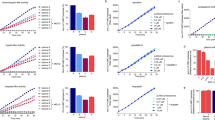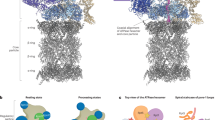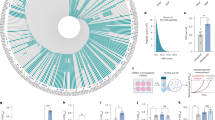Abstract
Intracellular protein degradation by the ubiquitin-proteasome system is ATP dependent, and the optimal ATP concentration to activate proteasome function in vitro is ∼100 μM. Intracellular ATP levels are generally in the low millimolar range, but ATP at a level within this range was shown to inhibit proteasome peptidase activities in vitro. Here, we report new evidence that supports a hypothesis that intracellular ATP at the physiological levels bidirectionally regulates 26S proteasome proteolytic function in the cell. First, we confirmed that ATP exerted bidirectional regulation on the 26S proteasome in vitro, with the optimal ATP concentration (between 50 and 100 μM) stimulating proteasome chymotrypsin-like activities. Second, we found that manipulating intracellular ATP levels also led to bidirectional changes in the levels of proteasome-specific protein substrates in cultured cells. Finally, measures to increase intracellular ATP enhanced, while decreasing intracellular ATP attenuated the ability of proteasome inhibition to induce cell death. These data strongly suggest that endogenous ATP within the physiological concentration range can exert a negative impact on proteasome activities, allowing the cell to rapidly upregulate proteasome activity on ATP reduction under stress conditions.
Similar content being viewed by others
Log in or create a free account to read this content
Gain free access to this article, as well as selected content from this journal and more on nature.com
or
References
Hershko A, Ciechanover A . The ubiquitin system. Annu Rev Biochem 1998; 67:425–479.
Mizushima N, Levine B, Cuervo AM, Klionsky DJ . Autophagy fights disease through cellular self-digestion. Nature 2008; 451:1069–1075.
Korolchuk VI, Mansilla A, Menzies FM, Rubinsztein DC . Autophagy inhibition compromises degradation of ubiquitin-proteasome pathway substrates. Mol Cell 2009; 33:517–527.
Besche HC, Peth A, Goldberg AL . Getting to first base in proteasome assembly. Cell 2009; 138:25–28.
Smith DM, Kafri G, Cheng Y, Ng D, Walz T, Goldberg AL . ATP binding to PAN or the 26S ATPases causes association with the 20S proteasome, gate opening, and translocation of unfolded proteins. Mol Cell 2005; 20:687–698.
Liu CW, Li X, Thompson D, et al. ATP binding and ATP hydrolysis play distinct roles in the function of 26S proteasome. Mol Cell 2006; 24:39–50.
Asher G, Bercovich Z, Tsvetkov P, Shaul Y, Kahana C . 20S proteasomal degradation of ornithine decarboxylase is regulated by NQO1. Mol Cell 2005; 17:645–655.
Davies KJ . Degradation of oxidized proteins by the 20S proteasome. Biochimie 2001; 83:301–310.
Ravid T, Hochstrasser M . Diversity of degradation signals in the ubiquitin-proteasome system. Nat Rev Mol Cell Biol 2008; 9:679–690.
Zhang F, Hu Y, Huang P, Toleman CA, Paterson AJ, Kudlow JE . Proteasome function is regulated by cyclic AMP-dependent protein kinase through phosphorylation of Rpt6. J Biol Chem 2007; 282:22460–22471.
Gribble FM, Loussouarn G, Tucker SJ, Zhao C, Nichols CG, Ashcroft FM . A novel method for measurement of submembrane ATP concentration. J Biol Chem 2000; 275:30046–30049.
Larcombe-McDouall J, Buttell N, Harrison N, Wray S . In vivo pH and metabolite changes during a single contraction in rat uterine smooth muscle. J Physiol 1999; 518:783–790.
Dragon S, Hille R, Gotz R, Baumann R . Adenosine 3′:5′-cyclic monophosphate (cAMP)-inducible pyrimidine 5′-nucleotidase and pyrimidine nucleotide metabolism of chick embryonic erythrocytes. Blood 1998; 91:3052–8.
Kawashima S . Inhibition of rat liver transglutaminase by nucleotides. Experientia 1991; 47:709–712.
Powell SR, Davies KJ, Divald A . Optimal determination of heart tissue 26S-proteasome activity requires maximal stimulating ATP concentrations. J Mol Cell Cardiol 2007; 42:265–269.
Geng Q, Romero J, Saini V, et al. A subset of 26S proteasomes is activated at critically low ATP concentrations and contributes to myocardial injury during cold ischemia. Biochem Biophys Res 2009; 390:1136–1141.
Ottenheijm CA, Heunks LM, Li YP, et al. Activation of the ubiquitin-proteasome pathway in the diaphragm in chronic obstructive pulmonary disease. Am J Respir Crit Care Med 2006; 174:997–1002.
Pettersen EO, Juul NO, Ronning OW . Regulation of protein metabolism of human cells during and after acute hypoxia. Cancer Res 1986; 46:4346–4351.
Bence NF, Sampat RM, Kopito RR . Impairment of the ubiquitin-proteasome system by protein aggregation. Science 2001; 292:1552–1555.
Liu J, Chen Q, Huang W, et al. Impairment of the ubiquitin-proteasome system in desminopathy mouse hearts. FASEB J 2006; 20:362–364.
Kumarapeli AR, Horak KM, Glasford JW, et al. A novel transgenic mouse model reveals deregulation of the ubiquitin-proteasome system in the heart by doxorubicin. FASEB J 2005; 19:2051–2053.
Saeki Y, Tanaka K . Unlocking the proteasome door. Mol Cell 2007; 27:865–867.
Depre C, Wang Q, Yan L, et al. Activation of the cardiac proteasome during pressure overload promotes ventricular hypertrophy. Circulation 2006; 114:1821–1828.
Mitch WE, Goldberg AL . Mechanisms of muscle wasting. The role of the ubiquitin-proteasome pathway. N Engl J Med 1996; 335:1897–1905.
Testelmans D, Crul T, Maes K, et al. Atrophy and hypertrophy signaling in the diaphragm of patients with COPD. Eur Respir J 2010; 35:549–556.
van Hees HW, Li YP, Ottenheijm CA, et al. Proteasome inhibition improves diaphragm function in congestive heart failure rats. Am J Physiol Lung Cell Mol Physiol 2008; 294:L1260–L1268.
Wojcik C, Di Napoli M . Ubiquitin-proteasome system and proteasome inhibition: new strategies in stroke therapy. Stroke 2004; 35:1506–1518.
Sadiq F, Crompton LA, Scaife JR, Lomax MA . Effect of prolonged intravenous glucose and essential amino acid infusion on nitrogen balance, muscle protein degradation and ubiquitin-conjugating enzyme gene expression in calves. Nutr Metab 2008; 5:5.
Mikura M, Yamaoka I, Doi M, et al. Glucose infusion suppresses surgery-induced muscle protein breakdown by inhibiting ubiquitin-proteasome pathway in rats. Anesthesiology 2009; 110:81–88.
Leij-Halfwerk S, Agteresch HJ, Sijens PE, Dagnelie PC . Adenosine triphosphate infusion increases liver energy status in advanced lung cancer patients: an in vivo 31P magnetic resonance spectroscopy study. Hepatology 2002; 35:421–424.
Mizushima N, Levine B, Cuervo AM, Klionsky DJ . Autophagy fights disease through cellular self-digestion. Nature 2008; 451:1069–1075.
Korolchuk VI, Mansilla A, Menzies FM, Rubinsztein DC . Autophagy inhibition compromises degradation of ubiquitin-proteasome pathway substrates. Mol Cell 2009; 33:517–27.
Yeo EJ, Chun YS, Park JW . New anticancer strategies targeting HIF-1. Biochem Pharmacol 2004; 68:1061–1069.
Hockel M, Vaupel P . Tumor hypoxia: definitions and current clinical, biologic, and molecular aspects. J Natl Cancer Inst 2001; 93:266–276.
Ogiso Y, Tomida A, Lei S, Omura S, Tsuruo T . Proteasome inhibition circumvents solid tumor resistance to topoisomerase II-directed drugs. Cancer Res 2000; 60:2429–2434.
Hideshima T, Richardson P, Chauhan D, et al. The proteasome inhibitor PS-341 inhibits growth, induces apoptosis, and overcomes drug resistance in human multiple myeloma cells. Cancer Res 2001; 61:3071–3076.
Wang X, Su H, Ranek MJ . Protein quality control and degradation in cardiomyocytes. J Mol Cell Cardiol 2008; 45:11–27.
Eguchi Y, Shimizu S, Tsujimoto Y . Intracellular ATP levels determine cell death fate by apoptosis or necrosis. Cancer Res 1997; 57:1835–1840.
Leist M, Single B, Castoldi AF, Kuhnle S, Nicotera P . Intracellular adenosine triphosphate (ATP) concentration: a switch in the decision between apoptosis and necrosis. J Exp Med 1997; 185:1481–1486.
Kwong JQ, Henning MS, Starkov AA, Manfredi G . The mitochondrial respiratory chain is a modulator of apoptosis. J Cell Biol 2007; 179:1163–77.
Latta M, Kunstle G, Leist M, Wendel A . Metabolic depletion of ATP by fructose inversely controls cd95- and tumor necrosis factor receptor 1–mediated hepatic apoptosis. J Exp Med 2000; 191:1975–1986.
Liu J, Zheng H, Tang M, Ryu X, Wang X . A therapeutic dose of doxorubicin activates ubiquitin-proteasome system-mediated proteolysis by acting on both the ubiquitination apparatus and proteasome. Am J Physiol Heart Circ Physiol 2008; 295:H2541–2550.
Yang H, Zhou P, Huang H, et al. Shikonin exerts antitumor activity via proteasome inhibition and cell death induction in vitro and in vivo. Int J Cancer 2009; 124:2450–2459.
Dong X, Liu J, Zheng H, et al. In situ dynamically monitoring the proteolytic function of the ubiquitin-proteasome system in cultured cardiac myocytes. Am J Physiol Heart Circ Physiol 2004; 287:H1417–1425.
Humphrey SM, Holliss DG, Seelye RN . Adenine pool catabolism in the ischemic, the calcium-depleted ischemic, and the substrate free anoxic isolated rat heart: relationship to contracture development. J Mol Cell Cardiol 1984; 16:1127–1136.
Acknowledgements
This work was supported by the National High Technology Research and Development Program of China (Project 2006AA02Z4B5), the National Natural Science Foundation of China (Project 2010), and a Key Project (9251018201002) of Guangdong Province Natural Science Foundation (to JL). It was also supported in part by Grants HL072166, HL085629, and HL068936 of the NIH and an Established Investigator Award (0740025N) of the American Heart Association (to XW).
Author information
Authors and Affiliations
Corresponding authors
Rights and permissions
About this article
Cite this article
Huang, H., Zhang, X., Li, S. et al. Physiological levels of ATP negatively regulate proteasome function. Cell Res 20, 1372–1385 (2010). https://doi.org/10.1038/cr.2010.123
Received:
Revised:
Accepted:
Published:
Issue date:
DOI: https://doi.org/10.1038/cr.2010.123
Keywords
This article is cited by
-
Structural and biochemical evidence that ATP inhibits the cancer biomarker human aldehyde dehydrogenase 1A3
Communications Biology (2022)
-
Gender-specific changes in energy metabolism and protein degradation as major pathways affected in livers of mice treated with ibuprofen
Scientific Reports (2020)
-
Inhibition of USP14 enhances the sensitivity of breast cancer to enzalutamide
Journal of Experimental & Clinical Cancer Research (2019)
-
Inhibition of EGFR signaling with Spautin-1 represents a novel therapeutics for prostate cancer
Journal of Experimental & Clinical Cancer Research (2019)
-
Growth arrest and apoptosis induction in androgen receptor-positive human breast cancer cells by inhibition of USP14-mediated androgen receptor deubiquitination
Oncogene (2018)



